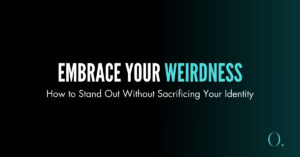Building a powerful personal brand is one of the most critical elements to success in the modern business world.
Whether you’re an entrepreneur, a writer, a musician, an artist, or someone who’s looking for a better job, you must focus on building your personal brand and becoming a thought leader in your industry.
Personal branding has become one of the most common subjects in entrepreneurship due to its great impact on business outcomes. In other words, a personal brand has a direct effect on generating more income and making more profit.
Some of the benefits of building a powerful personal brand include standing out from the crowd in a competitive market, becoming more recognized online and in person, expanding your network, generating new business, increasing leverage, and having a greater impact.
What is personal branding?
Personal branding is the process of crafting your public persona to communicate your vision, values, beliefs, and purpose.
Your personal brand is a reflection of the unique combination of your skills, experience, and your personality.
It’s how you look, what you dress, your body language, your tone of voice, the words you use, the stories you tell, and the people you associate with. It’s how you present yourself.
More importantly, it’s the ideas you support, the way you approach your work, the results you generate, how you generate them, and the impact you have on the world.
Step 1: Define your brand vision
A brand vision is an aspirational image of your brand’s future. It should paint an inspiring picture of the desired impact of your work and support your business strategy.
To define your brand vision you need to answer the following questions:
1) What do you do?
If you write, what you do isn’t just writing. If you’re a non-fiction writer for example, you are an educator. But that’s not enough. What do you educate people about? Is it business, is it health, is it psychology?
If it’s business, is it marketing? If it’s marketing, is it digital advertising, content creation, or email marketing? I’m sure you see the point now.
It doesn’t have to be one thing only, but you need to be as specific as possible.
2) Who do you do it for?
Whatever it is that you do, you should know exactly who you do it for. For example, if you’re a musician, who is your ideal audience? If you play heavy metal music, your ideal audience are people who listen to heavy metal.
If the pop-rock audience doesn’t enjoy what you do, who the hell cares?! They’re not your target audience, and you shouldn’t worry about them. Focus your efforts on satisfying the metalheads.
3) Why do you do it?
What’s your brand’s purpose? Why do you do what you do? Finding your Why is the most important step in building a powerful personal brand. It is the ultimate defining factor of your brand vision.
Your Why must go beyond yourself. It should come from a genuine desire to contribute and add value. For example, as a guitar instructor, my Why is to help my students find and express their unique voice on their instrument in the shortest amount of time possible.
For more on this subject, I highly recommend that you check Simon Sinek’s books Start With Why and Find Your Why.
Step 2: Define your brand values
1) What do you stand for?
Brand values don’t have to be complicated. What you stand for could simply be one word. I always think of Volvo as a great example. You can ask anyone what does Volvo stand for and they’ll tell you “safety” straight away.
Is Volvo the best brand out there? I don’t think so, but they stand for something and the whole world knows what that something is.
What do you want your audience to think of when they think of you? What’s that one word that resembles your work or your unique personality?
Words of caution: If you try to stand for several things at once, you’ll fail. People won’t remember you, and you won’t get anywhere.
2) What do you stand against?
Your personal brand isn’t only what you stand for, it’s also what you stand against. Being neutral is boring. Most people are afraid to stand against something, because they fear the conflict it creates.
I see it as a way of narrowing down your audience to only those whose values are aligned with your values. After all, they’re the ones who are going to believe in your mission and help you make your vision a reality.
You might create some enemies but you’ll create stronger allies. You become the voice of those who believe in the same things you believe in.
Keep in mind that whatever you stand with or against needs to be seen through your actions rather than just heard through your words. Share your opinions on hard matters and stick to your guns regardless of the pressure.
Step 3: Identify your brand personality
1) Choose your brand archetype
An archetype is a pattern of behavior and attributes that reflects a brand’s personality. According to Swiss psychologist Carl Jung there are 12 personality archetypes:
- The Ruler (confidence, control, authority, and power).
- The Artist (self expression, creativity, experimentation, and innovation).
- The Sage (wisdom, intelligence, truth seeking, and clarity).
- The Innocent (optimism, sense of wonder, honesty, and morality).
- The Explorer (freedom, independence, bravery, non-conformity).
- The Rebel (liberation, leadership, risk taking, bravery).
- The Hero (courage, mastery, self-sacrifice, and strength).
- The Magician (power, mastery, cleverness and charisma).
- The Jester (enjoyment, humor, awareness, and originality).
- The Everyman (belonging, fairness, altruism, and fairness).
- The Lover (intimacy, passion, sensuality, and vitality).
- The Caregiver (service, compassion, empathy, and patience).
Whether you can fully identify with one of the 12 brand archetypes or not, choose a primary archetype that resonates with you the most. Then, choose a secondary and a tertiary archetype to remain unique and authentic.
Your chosen blend of archetypes should serve as a guide for developing your brand personality and your brand story. It will help you create a theme around your content and create a strong emotional connection with your audience.
2) Define your brand voice
Brand voice is the distinct personality and communication style of your brand. Do you sound empowering and uplifting? Are you strict and authoritative? Do you sound friendly and supportive?
In personal branding, your brand’s voice is your own voice. How do you sound when you communicate? How do you make people feel? If you sound inspiring and aspirational, make a list of words that you can emphasize to amplify this feeling and a list of words that aren’t part of your vocabulary.
3) Define your brand tone
A brand tone is a subset of the brand’s voice. It should reflect the attitudes and convey the emotions based on the context of the communications. Different situations require a different tone of voice and you should adapt accordingly.
Step 4: Find your unique angle
Most problems have multiple solutions, and thus, can be approached from different angles. So, you need to find your own unique angle to approaching the problem that you solve. It makes a huge difference.
Physiotherapists, chiropractors, and osteopaths all work on similar problems, but each of them has their own approach to the problems they solve. Moreover, every good practitioner has their own preferred methods or techniques even if they fit under the same category.
Guitarists B.B King and Stevie Ray Vaughn both played the blues, but they had a different approach. They had their own signature sound due to the different ways they thought about the instrument. Same genre, same instrument, but a very distinct sound.
Some people find their unique angle after years of experience, and some others find it early on by following their natural interests and curiosities. So, what are you interested in? What do you enjoy researching? What are you so passionate about and how does it fit in the bigger picture?
Joe Rogan is most famous for his podcast The Joe Rogan Experience, but he’s also a Stand-up Comedian, UFC commentator, and a martial artist. This unique combination of skills, interests, and experiences is what makes him who he is.
So what makes you different than everyone else who offers the same service or plays the same instrument or writes about the same topic?
Step 5: Develop your story
The purpose of a good story is to build rapport with your audience. People don’t care about your message until they know that you’ve been where they are and have successfully made it to the other side.
You have to get comfortable being open and vulnerable with your audience. Share your flaws and imperfections. If you seem too perfect, you will lose people’s attention. You have to be relatable, so keep it real.
Your story should amplify your brand’s personality. It should be told in your brand’s voice and emphasize your character’s qualities. Furthermore, it should touch on your brand values and why they matter to you. It should invite your audience into the journey of exploration that led you to where you are today.
In the book Building a Story Brand, Donald Miller explains that your brand is not the hero, your customer is. Your brand story should guide your customer throughout the challenges they’ll face on their journey. It should position you as the credible guide that can hold their hand as they cross to the other side.
Developing a captivating brand story will get your audience to pay attention to what you’re saying and what you’re selling. It builds rapport and develops trust and credibility.
Step 6: Develop your visual identity
Now that you have a clear understanding of what you’re trying to communicate, it’s time to create a visual identity that amplifies your message.
1) Logo
A logo is a visual symbol that represents your brand. A good logo is distinctive, simple, and conveys the brand’s message.
When it comes to creating your logo, you will need to go through several iterations before you can make a good choice.
While there are services like Fiverr and 99 designs that can help you get your logo for a relatively cheap price, I prefer to hire a designer whose work I like and allow them to have their personal input in the creative process.
2) Colors
Once you have a good logo, you need to choose a color palette. Colors aren’t just an aesthetic element, they’re a powerful branding tool. They are an essential part of the brand experience.
Different colors resemble different things and create different emotions. What is the emotional response that you want to elicit? There are five basic colors (red, orange, yellow, green, and blue) plus the neutral colors (black, white, and gray).
In the book The 22 Immutable Laws of Branding, Al Ries and Laura Ries recommend sticking to one of the five basic colors rather than choosing an intermediate or mixed color. The authors also suggest that you should use colors that are opposite of your major competitors.
While colors can be very subjective, here’s a quick list of what the main colors resemble and some of the emotions they elicit:
- Red is an intense color that resembles energy, excitement, and passion.
- Orange is a cheerful color often associated with adventure, fun, and energy.
- Yellow is a warm color that signifies happiness, optimism, and hope.
- Green is the color of the environment. It’s natural and and used to elicit emotions of health, well-being, and abundance.
- Blue is the color of leadership. It’s a laid back color that is peaceful, tranquil, and resembles confidence and stability.
- Purple is the color of royalty. It is associated with creativity, spirituality, wisdom, and nobility.
- White is the color of purity. It evokes feelings of cleanliness, simplicity, peace, and virtue.
- Gray is a conservative color that resembles security, reliability, and intelligence.
- Black is the color of luxury, power, and seduction. It’s often associated with sophistication, mystery, and elegance.
When choosing your color palette, It’s best to pick 1 main color, 2 primary colors, 3 to 5 complementary colors, and 2 accent colors. But if it all sounds complicated, choose two main colors and add to your palette as you develop and grow your brand.
3) Typography
Like with color palettes, you need primary and secondary typefaces. Keep it simple and choose no more than 2 to 3 font families. When it comes to typefaces, readability is critical.
Don’t choose something just because it looks nice and artistic. Select fonts that are easy to read and test them in different sizes and different contexts. What would it look like on your website? Does it have the same look and feel when used in your email campaigns or social media posts?
Does it complement your brand voice? You want to select a font that is a good visual representation of the feeling your trying to convey. If your aim is to sound authoritative and powerful, choose a font that resembles power and authority.
4) Photography
Look, let’s face it, not every photo needs to have a message and serve a purpose. But every photo needs to be visually consistent with your brand. Your photos should focus on showing your personality and style.
You can start by curating photos that you like and sending them to your photographer as a reference for your next photoshoot. However, make sure you don’t copy other people, just use some examples for inspiration.
Your goal is to find your preferred style of photography and stick to it. When I think of consistency and style, I think of social media influencer Jenna Kutcher. Her Instagram account is a great example of a consistent and visually appealing theme.
5) Videography
Having a distinctive video style is not just about the equipment you use. Obviously, the better the camera and lens you’re using the better the quality. But it’s safe to say that nowadays you can film high quality videos using your smartphone.
The core elements that you need to keep in mind when filming your videos are your camera angles, lighting setup, audio quality, and editing style. Each and every element is an opportunity to differentiate yourself.
If you’re time poor and video content is a big part of what you do, I suggest you hire a professional videographer. You will still need to be the decision maker on what makes it to the final cut and what doesn’t, but at least you won’t be the one dealing with the tedious technical difficulties.
When it comes to developing your visual identity, a good rule of thumb is if you’re not feeling it, then it’s not the right choice. If it doesn’t speak to you and makes you want to advertise it to the masses, then it’s not going to create any leverage.
Step 7: Promote yourself
Obscurity is the enemy of personal brands. Building a brand means getting out of your comfort zone and becoming as visible as possible to your target audience. In order to achieve that, you’ll need to constantly promote yourself.
1) Build your network
Attend relevant networking events and stay active in your profession and community. Don’t just build relationships with potential clients and customers, but also with other professionals in your industry. The more visible you are, the stronger your brand becomes.
The best way to build a good network is by finding ways to add value to other people without expecting anything in return. If you think two people can benefit from knowing each other, then take the initiative to introduce them. Connect people together and you’ll be well-connected.
2) Build your online presence
Our world is becoming more digital by the minute. Building your online presence is a must, and it should be your highest priority. If you’re not actively promoting yourself online and growing your audience, you will soon become irrelevant.
I wrote another article that shows you how to promote yourself online in 7 simple steps and gain full control over your online presence. Read it and let it be your guide.
3) Leverage Collaborations
Instead of wasting your time and energy obsessing over the competition, focus on collaborating with other people in your industry and creating win-win situations. Life doesn’t have to be a zero-sum game, there’s enough for everyone.
Don’t always focus on growing your own share of the pie, sometimes you need to focus on making the whole pie bigger. Always look for ways to turn competition into collaboration and collaboration into leverage.
Final words
Building a powerful personal brand is a byproduct of creating meaningful work. All the above steps are irrelevant if your work has no real value. You don’t have to reinvent the wheel or become the most innovative person in your industry. You just need to make sure that you deliver so much value so that your success becomes inevitable.
There’s too much competition and too much noise, but there are endless opportunities for differentiation. Your personal brand will evolve as you grow and so will your visual representation of it. You don’t have to get it right from the start, keep experimenting and iterating and you’ll find what works best for you.
Remember, the word brand has an inherent long-term implication. So, be patient and keep it simple. Great brands weren’t built overnight, they are the result of compounding efforts over a long period of time.
If you need help promoting yourself or your business, please feel free to reach out by sending me a message on this page. You can also get in touch on LinkedIn or Twitter.
P.S Don’t forget to subscribe to the blog using the form below.




